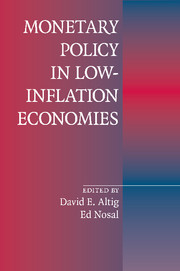Book contents
- Frontmatter
- Contents
- Contributors
- Acknowledgments
- Introduction
- 1 The Welfare Cost of Inflation in the Presence of Inside Money
- Commentary
- 2 An Open-Economy Model of Endogenous Price Flexibility
- Commentary
- 3 Efficient Inflation Targets for Distorted Dynamic Economies
- Commentary
- 4 Inflation and Welfare in Models with Trading Frictions
- Commentary
- 5 Good versus Bad Deflation: Lessons from the Gold Standard Era
- Commentary
- 6 Monetary Policy Orientation in Times of Low Inflation
- Commentary
- 7 Observations on Disinflation in Transition Economies
- Commentary
- 8 Inflation and Financial Market Performance: What Have We Learned in the Last Ten Years?
- Commentary
- Index
Commentary
Published online by Cambridge University Press: 26 January 2010
- Frontmatter
- Contents
- Contributors
- Acknowledgments
- Introduction
- 1 The Welfare Cost of Inflation in the Presence of Inside Money
- Commentary
- 2 An Open-Economy Model of Endogenous Price Flexibility
- Commentary
- 3 Efficient Inflation Targets for Distorted Dynamic Economies
- Commentary
- 4 Inflation and Welfare in Models with Trading Frictions
- Commentary
- 5 Good versus Bad Deflation: Lessons from the Gold Standard Era
- Commentary
- 6 Monetary Policy Orientation in Times of Low Inflation
- Commentary
- 7 Observations on Disinflation in Transition Economies
- Commentary
- 8 Inflation and Financial Market Performance: What Have We Learned in the Last Ten Years?
- Commentary
- Index
Summary
Keynes (1936) was right to emphasize that the investors' expectations have a paramount effect on the evolution of the national economy. Indeed, an important part of the role of the financial services sector in a modern economy is to try to forecast how the central bank will react to macroeconomic shocks, and any Wall Street economist worth his or her salt has a rule of thumb—a model drawn perhaps from some collective economic unconscious—that predicts how the Federal Open Market Committee will react to a bad inflation number or to a high unemployment figure. The high priest of the caste of economic forecasters—the Carl Jung of Wall Street economists—is John Taylor, whose elegant description (1993) of the Fed's putative policy rule has become a workhorse for modern macroeconomic analysis.
The essence of a simple version of Taylor's rule is that the Fed should raise nominal interest rates sharply if there is bad inflation news. This is the crux of how the Fed builds “credibility” in financial markets. Whenever there is a bad inflation number, the market is faced with a quandary: Is this a sign that the Fed is loosening monetary policy, or is it a signal that the Fed will tighten future interest rates to cool down a national economy that is perhaps overheated? Once investors have assimilated Taylor's “activist” policy rule, the market will react to an inflation shock assuming (correctly) that the Federal Open Market Committee is serious about maintaining low inflation.
- Type
- Chapter
- Information
- Monetary Policy in Low-Inflation Economies , pp. 81 - 88Publisher: Cambridge University PressPrint publication year: 2009



